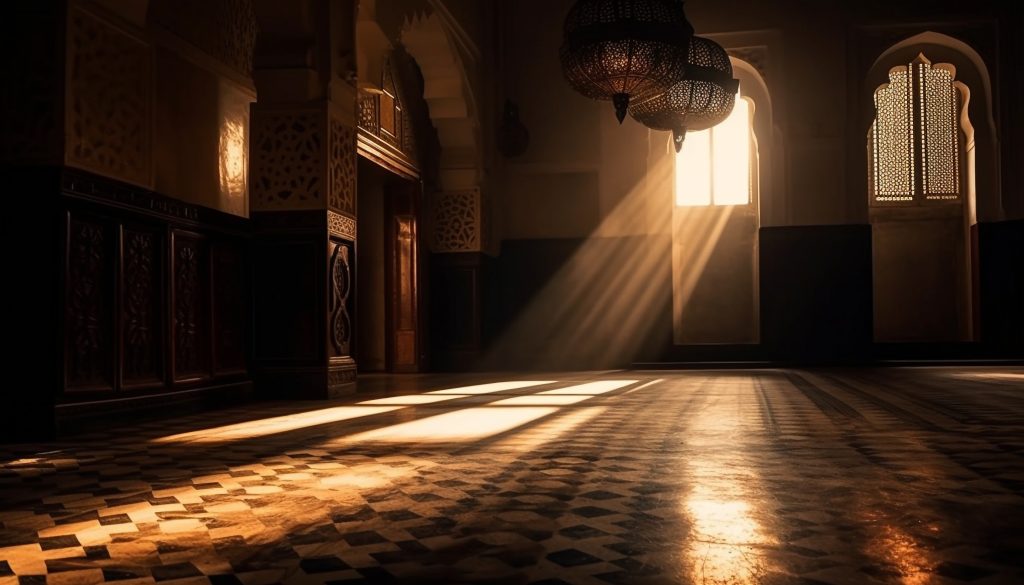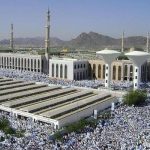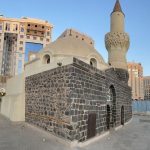At Umrah International, we believe that embarking on the pilgrimage of Umrah is more than just a journey to sacred sites; it is a transformative experience that deepens one’s faith and connection with Allah. As you prepare for this spiritual adventure, the timeless tales from Islamic history serve as guiding lights, illuminating the path ahead.
The Enigmatic Tale of the People of the Cave
A Historical Glimpse into the Past
The story of the People of the Cave, narrated in Surah Al-Kahf (Chapter 18 of the Qur’an), captures the hearts of believers with its profound themes of faith, perseverance, and divine protection. This narrative unfolds during a period of religious oppression, where the bravery of a few young believers stands in stark contrast to the tyranny of their king.
Unraveling the Mystery of the Inscription
The term “Inscription” invites multiple interpretations, ranging from a geographical landmark to a record of the youths’ extraordinary journey. Scholars have debated its meanings, adding layers of intrigue to an already captivating story. Imam Ja‘far as-Sadiq explained that the king of that time inscribed the names of these faithful youths on lead tablets, ensuring their legacy would be remembered.
The Call of the Faithful Youths
A Prayer for Divine Guidance
In their moment of fear and uncertainty, the youths cried out, “Our Lord! Grant us mercy from Thee, and provide for us a right course in our affair” (18:10). This prayer embodies the essence of reliance on Allah, demonstrating that true strength lies in humility and faith. Their plea serves as a reminder that, no matter the challenges faced, turning to Allah in supplication can illuminate the darkest paths.
The Courage Beyond Years
Despite their youth, these individuals exhibited remarkable courage in the face of oppression. Imam Ja‘far as-Sadiq emphasized that faith transcends age; a person’s belief can empower them to confront tyranny, regardless of how young or old they may be. This narrative reinforces the idea that spiritual fortitude knows no bounds.
The Divine Slumber: A Miracle Unfolds
The Protection of the Almighty
Upon entering the cave, the youths were enveloped in a deep sleep, a miraculous act of divine protection. This profound sleep was not just a refuge from danger but also a sign of Allah’s mercy and omnipotence. Their time in slumber became a testament to the wonders of faith, illustrating that true believers are safeguarded by divine will.
Awakening to a New Era
When the youths finally awoke, they were bewildered by the passage of time. Initially believing they had slept for only a day, their astonishment highlights the transformative nature of their experience. Their awakening serves as a metaphor for spiritual renewal, inviting believers to reflect on their own journeys toward enlightenment.
The Quest for Pure Nourishment
The Journey into the City
Determined to sustain themselves, the youths decided to send one of their number to procure food from the city. This decision illustrates their awareness of both the need for sustenance and the risks of being discovered. Their focus on finding “pure food” emphasizes the importance of righteousness, even amid adversity.
A Society Transformed
Upon entering the city, their companion discovered a world transformed by time. The drastic changes he encountered served as a poignant reminder of the passage of time and the enduring nature of faith. This contrast invites reflection on how societal shifts can challenge but ultimately strengthen individual beliefs.
The Revelation of Their Legacy
The King’s Discovery
News of the youths quickly spread, drawing the attention of the king and the townsfolk. Their varying accounts of the number of youths—three, five, or seven—underscore humanity’s fascination with the miraculous. This intrigue illustrates how the narratives of faith can captivate hearts and inspire discussions across generations.
Building a Place of Reverence
Recognizing the significance of the cave and the miraculous story of the youths, the king proposed to build a mosque to honor their legacy. This act highlights the importance of preserving sacred stories and spaces that inspire spiritual growth and collective remembrance of faith.
Timeless Lessons from the Cave
The Power of Collective Faith
The narrative of the People of the Cave emphasizes the strength found in community and shared beliefs. Their unwavering commitment to Allah amid persecution serves as an enduring lesson for all believers. The story encourages us to find strength in unity, illustrating how collective faith can empower individuals to confront trials with resilience.
Seeking Divine Guidance
Throughout their ordeal, the youths consistently sought Allah’s guidance, emphasizing the importance of maintaining a close relationship with the Creator. Their story inspires believers to engage in prayer and supplication, reminding us that divine guidance can provide solace in challenging times.
Unveiling the Legacy of the People of the Cave: A Profound Journey of Faith and Resistance
In various authentic traditions, it is reported that an esteemed Imam conveyed to his companions the importance of standing firm in the face of societal pressure. He recounted how a community once compelled its members to abandon their faith, much like the persecution faced by the People of the Cave. The Imam identified the root of this pressure: “Polytheism.” While they outwardly practiced Taqiyyah—concealment of their beliefs—true faith remained steadfast in their hearts. Eventually, Allah liberated them from their oppressive society. Their courageous defiance against a tyrannical ruler earned them divine rewards, illustrating the value of truth over falsehood.
The Essence of Faith: The Role of Taqiyyah
Taqiyyah, the practice of concealing one’s faith, allowed these believers to navigate a hostile environment while preserving their spirituality. The Imam emphasized that their covert rejection of polytheism surpassed mere silence in faith; it was an active resistance that brought them closer to divine favor. This highlights a profound concept: the sanctity of faith transcends outward appearances.
The Journey to Solitude: A Collective Awakening
According to various accounts, the youths abandoned their homes one by one, ultimately converging in a secluded forest. Here, they shared vows and revealed their innermost thoughts, discovering a shared commitment to faith. This camaraderie was instrumental in their spiritual journey, as it confirmed their identities as Mu’min (believers), united by a singular intention of devotion to Allah.
Confrontation with Authority: A Test of Faith
The Imam narrated a poignant episode involving a group of Jewish scholars who questioned a caliph regarding divine mysteries. Their inquiries, seemingly trivial, challenged the leadership and called for deeper understanding. The caliph, perplexed, turned to Ali for answers. This moment underscores the significance of knowledge in confronting authority and navigating faith.
The Wisdom of Ali: Bridging Faith and Knowledge
Ali’s responses to the scholars not only highlighted his wisdom but also served as a catalyst for their conversion to Islam. His explanations ranged from metaphysical concepts to tangible realities, revealing the interconnectedness of faith and rational inquiry. The act of answering difficult questions became a profound demonstration of faith, compelling two scholars to embrace Islam and challenging the third to seek further enlightenment.
The Cave of Revelation: The Tale of the People of the Cave
When asked about a group that had experienced an extraordinary slumber for 309 years, Ali recited Surah Kahf, revealing the rich narrative of the People of the Cave. This group sought refuge from a tyrannical ruler, Decius, who represented oppressive authority and polytheism. Their eventual retreat to the cave became a symbol of divine protection and the resilience of faith against tyranny.
The Majesty of the Cave: A Testament to Divine Will
Ali described the elaborate palace of Decius, emphasizing the stark contrast between earthly power and spiritual truth. The luxurious surroundings served to inflate the king’s ego, leading him to claim divinity. In stark defiance, the cave dwellers chose truth over falsehood, understanding that genuine strength lies in faith, not in material wealth or tyrannical control.
Companions in Faith: A Journey of Sacrifice
The youths’ journey to the cave was marked by profound sacrifices, as they abandoned their possessions and comfort in pursuit of a higher truth. Their resolve was tested when they encountered challenges, including hunger and the fear of being discovered. Yet, their unity in purpose fortified their spirits, demonstrating that faith thrives in community and shared struggles.
The Role of the Shepherd and the Dog
Upon meeting a shepherd, the youths’ story resonated deeply with him, prompting his loyalty and willingness to assist. His faithful dog, Qitmir, emerged as a protective guardian, embodying loyalty and courage in the face of adversity. This symbiotic relationship between humans and animals further underscores the theme of companionship in the quest for truth.
Awakening After Centuries: A Return to Reality
After years of divine slumber, the People of the Cave awoke to a transformed world, their hearts filled with a mix of disbelief and wonder. The changes in their society, marked by the emergence of new beliefs, highlighted the fluidity of faith and the enduring power of truth.
The Moment of Revelation: A New Era
Tamleekhaa’s venture into the city revealed profound changes, prompting him to recognize the miraculous transformation of his surroundings. The encounter with a new king, who embodied the values of justice and truth, symbolized the victory of faith over tyranny. This moment serves as a reminder that faith can emerge victorious even in the face of overwhelming odds.
The Return to the Cave: A Divine Encounter
The eventual return of Tamleekhaa and his companions to the cave illustrated a profound connection to their past and the enduring impact of their faith. Their desire for redemption and understanding led to a collective prayer, culminating in a powerful moment of divine intervention.
The Legacy of the Cave: A Testament to Truth
The subsequent events in the cave—a testament to the profound importance of truth—reaffirm the belief that honesty and righteousness in one’s actions resonate with divine approval. The story of the People of the Cave serves as a timeless reminder of the enduring strength of faith, loyalty, and the quest for truth.
The Enduring Message of Faith and Resistance
The narrative of the People of the Cave is not merely a historical account but a rich tapestry of spiritual and moral lessons. It emphasizes the importance of community, the value of Taqiyyah, and the unwavering pursuit of truth in the face of oppression. This legacy continues to inspire believers, encouraging them to remain steadfast in their faith, regardless of the challenges they may face in an ever-changing world.
The People of the Cave
The narrative of Asahab Al-Kahf, or the People of the Cave, is a profound story from the Quran that conveys deep spiritual lessons. This account, found in Surah Al-Kahf (18:9-26), addresses themes of faith, divine protection, and the nature of time, serving as a source of inspiration for believers throughout history. In this article, we will delve into the various aspects of this narrative, exploring its context, key themes, and lasting significance.
Context and Significance of the Tale
The story unfolds during a time of persecution against those who held monotheistic beliefs. The youths, disillusioned by the polytheism of their society, chose to seek refuge in a cave, demonstrating their commitment to their faith in the face of adversity. Their flight represents a universal struggle against oppression and a quest for spiritual truth.
The Cave as a Symbol
The cave itself symbolizes safety and divine mercy. It becomes a sacred space where the youths experience not only physical protection but also a transformative encounter with the divine. This setting plays a crucial role in the unfolding of their miraculous story.
The Youths’ Prayer for Mercy
Seeking Divine Help
Upon entering the cave, the youths earnestly prayed to God, asking for mercy and guidance:
“Our Lord! Grant us mercy from Thee, and provide for us a right course in our affair.” (18:10)
This heartfelt plea reflects their unwavering faith and reliance on divine support during their trials.
God’s Response
In response to their sincere prayers, God caused them to enter a deep sleep, shielding them from the threats of the outside world:
“So We prevented them from hearing in the cave for a number of years.” (18:11)
This act highlights the importance of seeking refuge in God and the power of faith in protecting the believer.
The Miraculous Slumber
A Period of Divine Intervention
The youths remained in their slumber for many years, completely unaware of the passage of time:
“Then We raised them up that We might know which of the two parties was best able to compute the time for which they remained.” (18:12)
This miraculous occurrence emphasizes God’s control over time and life itself, reinforcing the idea that divine intervention can alter the course of human experience.
Awakening and Reflection
Upon awakening, the youths engaged in a conversation about how long they had slept, revealing their astonishment at the passage of time:
“A speaker among them said: How long have you tarried? They said: We have tarried for a day or a part of a day.” (18:19)
This moment serves as a pivotal turning point in their journey, prompting them to reflect on their situation and their faith.
The Decision to Venture Out
A Test of Caution
Realizing the need for sustenance, the youths decided to send one among them to the city with a silver coin:
“Now send one of you with this silver (coin) of yours to the city, then let him see which of them has purest food, so let him bring you provision from it, and let him behave with gentleness, and by no means make your case known to any one.” (18:19)
They instructed him to be discreet and to avoid revealing their identities. This decision underscores the delicate balance between faith and pragmatism.
The Risk of Exposure
The youth’s return to the city posed significant dangers; if discovered, they could face dire consequences:
“For surely if they prevail against you they would stone you to death or force you back to their religion, and then you will never succeed.” (18:20)
Their cautious approach highlights the constant threat faced by believers in a hostile environment and the need for wisdom in navigating such challenges.
Discovering a Transformed Society
The Change in the City
When the young man entered the city, he found that the landscape of belief had shifted dramatically. The townspeople had embraced monotheism, a testament to the power of faith and the fulfillment of God’s promises:
“And thus did We make (men) to get knowledge of them that they might know that Allah’s promise is true and that as for the hour there is no doubt about it.” (18:21)
This change illustrates the profound impact of the youths’ faith journey on the broader community.
The Reaction of the People
The story of the youths generated curiosity and intrigue among the people, prompting discussions about their existence and the significance of their tale. This reaction illustrates the impact of their faith journey on the broader community.
The Significance of Their Story
A Lesson for Future Generations
The tale of the People of the Cave serves as a divine sign for believers, reminding them of the truth of God’s promises and the reality of the Day of Judgment. It emphasizes the importance of faith, patience, and reliance on divine guidance:
“And do not say of anything: Surely I will do it tomorrow, unless Allah pleases.” (18:23)
This highlights the importance of humility in the face of divine will.
The Debate Among the People
The townspeople debated how to honor the youths, ultimately deciding to erect a masjid over them:
“When they disputed among themselves about their affair and said: Erect an edifice over them, their Lord best knows them.” (18:21)
This act reflects a shift in societal values and the recognition of the importance of faith in shaping community identity.
Speculations on Their Number
The Various Accounts
There are varying opinions regarding the number of youths and their dog. Some say they were three, others five, and yet others claim they were seven:
“(Some) say: (They are) three, the fourth of them being their dog; and (others) say: Five, the sixth of them being their dog, making conjectures at what is unknown; and (others yet) say: Seven, and the eighth of them is their dog.” (18:22)
These differing accounts illustrate humanity’s tendency to speculate about the unknown.
The Divine Knowledge
The Quran emphasizes that only God knows the true number of the youths:
“Say: My Lord best knows their number, none knows them but a few.” (18:22)
This underscores His omniscience and the futility of excessive speculation. It serves as a reminder to focus on clear divine signs rather than engage in fruitless debates.
The Duration of Their Slumber
A Period of Three Hundred Years
The youths remained in the cave for an astonishing three hundred years, with some accounts adding an additional nine years:
“And they remained in their cave three hundred years and (some) add (another) nine.” (18:25)
This prolonged duration highlights the extraordinary nature of their story and God’s ability to manipulate time.
The Nature of Time in Faith
The long slumber symbolizes the timelessness of faith and the idea that true belief transcends the physical constraints of time. It invites reflection on the nature of existence and the divine plan.
Modern Reflections
Relevance for Today’s Believers
The story of the People of the Cave continues to resonate with individuals today, providing lessons on perseverance, faith, and the importance of community. It encourages believers to remain steadfast in their convictions, even amidst challenges.
The Enduring Power of Faith
Asahab Al-Kahf stands as a testament to the transformative power of faith and the significance of divine guidance in navigating life’s trials. It invites contemporary believers to reflect on their own journeys and the timeless nature of faith in a changing world.
Top of Form
Bottom of FormResilience in the Face of Adversity
In a world filled with uncertainty, the story of the People of the Cave remains profoundly relevant. It serves as a powerful reminder that faith can provide clarity and strength during tumultuous times. For many, the lessons gleaned from this narrative inspire a commitment to remain steadfast in belief, reinforcing the idea that spirituality can be a refuge.
Umrah as a Pathway to Enlightenment
For pilgrims undertaking Umrah, this journey offers a unique opportunity to reflect on the trials faced by the People of the Cave. Just as they sought refuge in their faith, modern-day pilgrims can find similar solace in their spiritual journey. Each prayer and step taken in the holy cities of Mecca and Medina can serve to deepen one’s connection with Allah.
Conclusion
The narrative of Asahab Al-Kahf is rich with spiritual and moral lessons, offering insights into the nature of faith, divine mercy, and the challenges faced by believers. It serves as a timeless reminder of the power of faith in the face of adversity and the importance of seeking refuge in God.
At Umrah International, we are committed to helping every traveler embark on a meaningful pilgrimage. The lessons learned from the People of the Cave resonate deeply with the essence of Umrah—seeking refuge in Allah, finding strength in faith, and embracing the transformative power of belief.
Join Us on Your Spiritual Journey
As you prepare for your pilgrimage, let the story of the People of the Cave inspire your heart and guide your intentions. We invite you to connect with Umrah International, allowing us to assist you in crafting a transformative experience that is enriching and spiritually fulfilling. Together, let us embark on this sacred journey, where every step taken leads to greater understanding and closeness to Allah.

















